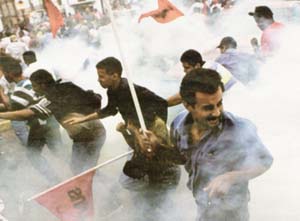


|
|
Police attack workers and students in Panama City protest steep bus fare hike. There is growing anger among working people over government's austerity measures.
|
The street demonstrations began May 1 after the government of President Mireya Moscoso announced the sharp fare increases. This latest measure acted as a detonator for growing class tensions and anger at the government's austerity policies. It followed the doubling of telephone charges for the smallest users, and increases in water and electricity rates.
The official unemployment rate in Panama rose from 11.7 percent in 1999 to 13.3 percent this year. The actual numbers are much higher. Thirty-seven percent of the country's population lives below the official poverty line.
The biggest demonstration took place May 10, when thousands of workers and students took to the streets of Panama City. They protested at the barricaded presidential palace. Firing volleys of tear gas and rubber bullets, riot police repelled the protesters, who then marched on the National Assembly. The protests spread to working-class districts such as Chorillo, one of the areas hardest hit by U.S. bombers and troops during the 1989 invasion.
Dozens of students and workers were injured, and more than 200 arrested. At least 14 people were shot.
By the end of the day Vice President Arturo Vallarino announced that the government would reconsider the price hikes. Marcos Allen, leader of the National Confederation of Workers, blamed the government for the violence and vowed the protests would continue.
The groups organizing the protests included the National Council of Organized Workers, Federation of Public Employees, National Transportation Council, and National Movement for Defense of Sovereignty (MONADESO), a grouping of labor and other mass organizations. Leaders of MONADESO refused to join with other organizations in negotiations with government officials that took place at the presidential palace, saying it was not neutral ground.
The ruling class was clearly taken aback by the scope and intensity of the resistance, and tried to undercut it. Moscoso claimed in a nationally televised address that "backward-looking" elements were using the population to attack the government.
Officials blame Cuba for protests
Trying to pin the blame for the crisis on something other than his government's policies, Justice Minister Winston Spadafora publicly pointed a finger at "foreign ideologies" after the huge May 10 protest, saying that "an embassy accredited by Panama" was financing some of the groups that were fighting the fare hike. The mystery agitator was "widely thought to mean the Cuban embassy," reported the Financial Times.
The May 14 issue of the Panama City daily La Prensa published an article and a photo that it claimed showed Félix Luna Mederos, an official at the Cuban embassy, attending a meeting with some members of the construction workers union and student groups.
Cuba's ambassador to Panama, Carlos Zamora, rejected the accusations and denied the man in the photo was Luna. "We are very respectful of the principle of non-intervention as a basic principle of our foreign policy," Zamora said.
Relations between the governments of Cuba and Panama have been strained since the Moscoso regime refused to extradite CIA-trained terrorist Luis Posada Carriles. At the time of an Ibero-American summit last November, he was arrested in Panama after his presence was exposed by Cuban president Fidel Castro.
Posadas Carriles has been involved in numerous attempts to assassinate the Cuban leader, and took part in a 1976 bombing of a Cuban airliner over Barbados that killed all 73 passengers and crew.
Specter of the Dignity Battalions
The Reuters news agency called the protests in Panama City "the worst night of rioting and looting in Panama since the 1989 U.S. invasion" that toppled the government of Manuel Noriega and installed a government--headed by Guillermo Endara, sworn in on a U.S. military base--that was more to Washington's liking.
Labeling protesting workers and students "rioters" and "looters" is nothing new for the big-business media. The description of "rioting" after the 1989 U.S. invasion is a reference to the widespread resistance to the U.S. occupation forces.
In December 1989, Washington and the capitalist media employed similar terms to describe the Dignity Battalions, civilian militias of Panamanian workers and peasants--many of them Black--who put up stiff resistance to the occupation by 26,000 U.S. troops. Thousands were killed in the invasion, and thousands more left homeless. Washington bombed whole neighborhoods into rubble.
Cuban president Castro praised the Dignity Battalions as "heroes of Our America who are fighting for dignity, honor, and sovereignty of our peoples." He noted that Washington, whose forces took several weeks to assert their control, underestimated the resistance by working people.
The purpose of the U.S. invasion was to install a client regime, crush the struggle there for national sovereignty and social justice, undermine the Panama Canal Treaties, ensure the use of U.S. military bases in the country, and strengthen U.S. domination in the region. Panamanian leader Manuel Noriega, accused of drug trafficking charges because his regime did not always go along with Washington, was seized by U.S. troops, and then tried and convicted in a U.S. court.
Panamanian students and others have accused the current president, Moscoso, of bowing to U.S. demands, not only in implementing austerity measures but in refusing to extradite Posada Carriles to Cuba.
Front page (for this issue) |
Home |
Text-version home